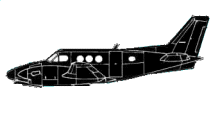
ASN Wikibase Occurrence # 207205
This information is added by users of ASN. Neither ASN nor the Flight Safety Foundation are responsible for the completeness or correctness of this information.
If you feel this information is incomplete or incorrect, you can submit corrected information.
| Date: | Saturday 23 July 2016 |
| Time: | 19:00 LT |
| Type: |  Beechcraft A90 King Air |
| Owner/operator: | Private |
| Registration: | N256TA |
| MSN: | LJ-256 |
| Year of manufacture: | 1967 |
| Total airframe hrs: | 14543 hours |
| Engine model: | Pratt & Whitney PT6A-20 |
| Fatalities: | Fatalities: 0 / Occupants: 15 |
| Aircraft damage: | Substantial |
| Location: | Byron, CA -
 United States of America United States of America
|
| Phase: | En route |
| Nature: | Parachuting |
| Departure airport: | Byron, CA (C83) |
| Byron, CA (C83) | |
| Investigating agency: | NTSB |
| Confidence Rating: |
The commercial pilot reported that, while setting up for a skydiving jump run, the airspeed was a little slow, and the airplane abruptly stalled, rolled left, and began rotating downward. A jumper, seated in the copilot’s seat, stated that the pilot did not retard the throttles during the recovery attempt and that the airplane’s airspeed increased rapidly. The jumper also reported that he heard a “loud bang” during the recovery sequence. The pilot briefly recovered the airplane to a wings-level attitude, but it then subsequently stalled and entered another spin. During the second spin event, all the jumpers successfully egressed. After about nine rotations, the pilot recovered the airplane to a wings- and pitch-level attitude, and shortly thereafter, it broke off to the left and stalled and rotated downward again. The pilot recovered the airplane again and flew back to the airport because the airplane was handling abnormally, and he landed it without further incident.
After landing, a witness noted that the airplane’s right horizontal stabilizer and elevator were missing; they were subsequently recovered in a field a few miles south of the airport. Magnified optical examination revealed that all the fracture surfaces on the right horizontal stabilizer, elevator, and attachment bracket were consistent with overstress separations, which was likely the source of the loud bang heard by the jumper during the recovery sequence. No indications of fatigue or corrosion were observed. Therefore, it is likely that the right horizontal stabilizer and the attached elevator were overstressed during the airplane’s left spin recovery, which led to their in-flight separation. Due to the dynamics during a spin recovery, only the right horizontal stabilizer experienced g forces and air flow beyond its limit.
The Airplane Flight Manual contained a spin recovery procedure, which stated to “immediately move the control column full forward, apply full rudder opposite to the direction of the spin, and reduce power on both engines to idle. These three actions should be done as near simultaneously as possible.” It is likely that the pilot’s failure to follow these procedures led to the airplane’s airspeed rapidly increasing and caused increased air flow, which required additional g forces to recover.
Postaccident, the airplane’s weight and balance were calculated for the accident flight, and the center of gravity (CG) was determined to be about 6 to 7 units aft of the limit. An aft CG results in the airplane being in a less stable flight condition, which decreases the ability of the airplane to right itself after maneuvering and likely contributed to the pilot’s inability to maintain level flight.
Probable Cause: The pilot’s failure to maintain an adequate airspeed and his exceedance of the airplane’s critical angle of attack, which resulted in an aerodynamic stall and subsequent spin. Also causal to the accident was the pilot’s failure to follow prescribed spin recovery procedures, which resulted in increased airspeed and airflow and the subsequent overstress separation of the right horizontal stabilizer. Contributing to the accident was the pilot’s inadequate preflight weight and balance calculations, which resulted in the center of gravity being aft of the limit.
Accident investigation:
 |
|
Sources:
NTSB:
NTSB
https://app.ntsb.gov/pdfgenerator/ReportGeneratorFile.ashx?EventID=20160724X01920&AKey=1&RType=Final&IType=LA
Plane crashed in 2019, damaged beyond repair :
https://aviation-safety.net/wikibase/226410
History of this aircraft
Other occurrences involving this aircraft
| 21 June 2019 | N256TA | Oahu Parachute Center/N80896 LLC | 11 | near Dillingham Airfield, Oahu, HI |  |
w/o |
| Loss of control | ||||||
Location
Media:
Revision history:
| Date/time | Contributor | Updates |
|---|---|---|
| 08-Mar-2018 11:24 | ASN Update Bot | Added |
| 26-Jun-2019 11:13 | Iceman 29 | Updated [Time, Source, Embed code, Narrative] |
| 26-Jun-2019 11:15 | Iceman 29 | Updated [Source] |
| 17-Nov-2022 08:16 | Ron Averes | Updated [Aircraft type, Source] |
Corrections or additions? ... Edit this accident description
The Aviation Safety Network is an exclusive service provided by:


 ©2024 Flight Safety Foundation
©2024 Flight Safety Foundation